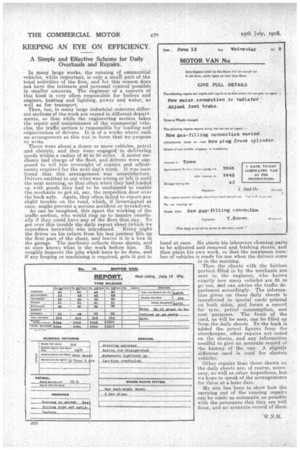KEEPING AN EYE ON EFFICIENCY.
Page 8

If you've noticed an error in this article please click here to report it so we can fix it.
A Simple and Effective Scheme for Daily Overhauls and Repairs.
In many large works, the running of commercial vehicles, while Important, is only a small part of the totalactivities of the firm, and for this reason does not have the intimate and personal control possible in smaller concerns. 'Phe engineer of a concern of this kind is very often responsible for boilers and engines, heating and lighting, power and water, as well a,s for transport. Then, too, in many large industrial concerns different sections of the work are vested in different departments, so that while the engineering section takes the repair and maintenance of the commercial vehicles, the traffic section is responsible for loading and organization of drivers. It is of a works where such an arrangement as this was in force that we rropose to write.
There were about a dozen or more vehicles, petrol and electric, and they were engaged in delivering 'goods within a radius of 40 to 50 miles. A motor mechanic had charge of the fleet, and drivers were supposed to tell him overnight of repairs and adjustments required for the next day's work. It was soon found that this arrangement was unsatisfactory. Drivers omitted to say what was wrong or left it until the next morning, so that often when they had loaded up with goods they had to be unshipped to enable the, mechanic to get at, say, the inspection door 'over the back axle, Again, they often failed to report any -slight trouble on the road, which, if investigated at once, might prevent a serious accident or breakdown.
As can be imagined, this upset the working of the traffic section, who would ring up to inquire caustically if they could have 'any of the fleet that clay. To get over this trouble the daily report sheet (which we reproduce herewith) was introduced. Every night the driver on his return from his last journey fills up the first part of the sheet, and leaves it in a box in the garage. The mechanic collects these sheets; and at once knows what is the work before him. He roughly,inspeets the jobs which have to be done, and if any forging or machining is required, gets it put in
hand at once. He starts his labourers cleaning parts to be adjusted and removed and fetching stores, and then plans 'his own work, so that the maximum number of vehicles is ready for use when the drivers come in in the morning. .
Then the sheets with the bottom portion filled in by the mechanic are sent to the engineer, who knows exactly how many vehicles are fit to go out, stmd can advise the traffic department accordingly. The information given on these daily sheets is transferred to special cards' printed en both sides,. and forms a record for tyre, petrol consumption, and cost purposes. The front of the card, as will be seen, can be filled up -from the daily sheets. To the back is added the petrol figures. from the storekeeper, other repairs not noted on the sheets, and any information needful to give an accurate record of the history of the van.. A slightly different card is used for electric vehicles.
Other repairs than those shown on the daily sheets are, of course, necessary, as well as other inspections, but we hope to speak of the arrangements for these at a later date.
--My aim has been to show how the carrying out of the running repairs can be triode as automatic as possible . with the assurance that they are well done, and an accurate record of them






















